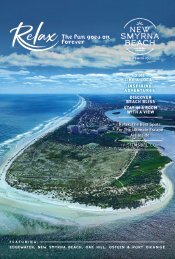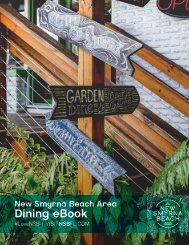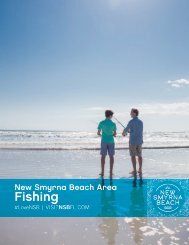2020NSB-11155-Arts&CultureeBook2020-1B
You also want an ePaper? Increase the reach of your titles
YUMPU automatically turns print PDFs into web optimized ePapers that Google loves.
New Smyrna Beach<br />
History<br />
New Smyrna Beach occupies a notable place in history as the second oldest city in Florida, the site of<br />
the largest single attempt at British colonization in the New World.<br />
First settled by Europeans in 1768, Dr. Andrew Turnbull, a Scottish physician, brought 1,400 indentured<br />
servants from Greece and Italy to East Florida. He established the colony of New Smyrna, named after<br />
the hometown of his wife. The majority of the colonists came from Menorca, one of the Mediterranean<br />
Balearic Islands of Spain, and were of Catalan culture and language. Although the colony produced<br />
relatively large amounts of processed indigo in its first few years of operation, it eventually collapsed<br />
after suffering major losses due to insect-borne diseases and Indian raids, and growing tensions caused<br />
by mistreatment of the colonists under Turnbull’s overseers. About 600 survivors marched nearly 70<br />
miles north on Old King’s Road and relocated to St. Augustine, where they settled by 1777. Descendants<br />
today can trace their names to the list on the statue of Father Pedro C<strong>amp</strong>os that stands in the courtyard<br />
of the Cathedral Basilica of St. Augustine. New Smyrna has been under the rule of four “flags”: the<br />
British, Spanish, United States, and the Confederate Jack.<br />
Museums<br />
Mary S. Harrell Black Heritage Museum<br />
314 N. Duss Street<br />
New Smyrna Beach, FL 32168<br />
386.478.1934<br />
blackheritagemuseum.org<br />
Monday – Friday: 10 a.m. – 4 p.m.<br />
Saturday: 1 p.m. – 4 p.m.<br />
Sunday: Closed<br />
The Mary S. Harrell Black Heritage Museum, formerly known as<br />
the Black Heritage Festival / Museum of New Smyrna Beach,<br />
Inc., is one of a few of its kind in the State of Florida. It is<br />
housed in the 19th century restored old Sacred Heart / St. Rita<br />
building, built in 1899. The structure was once a place of worship<br />
for a congregation of Black Roman Catholics. The Centennial<br />
Celebration was held December 11, 1999, marking 100 years of<br />
the building’s existence and the official opening of the museum.<br />
A permanent exhibit, the Heritage House, also known as the<br />
“shotgun house,” was later added and located just across the<br />
street from the museum, with period furniture and accessories.<br />
The museum is a non-profit organization dedicated to increasing awareness and appreciation for African<br />
American culture and history. Emphasizing the contributions of its people, the museum preserves and<br />
displays a collection of photos, oral histories, memorabilia and artifacts to educate citizens about the<br />
history of race relations in small-town Florida over the course of the twentieth century. The photos<br />
and oral histories speak of the hardships and triumphs of this African American community from the<br />
early 1900s to the present. This museum is the cornerstone of the historic West Side community in<br />
New Smyrna Beach, Florida and resides in the old Sacred Heart/St. Rita church building constructed<br />
in 1899. The museum is open Wednesday through Saturday, 1 p.m. – 4 p.m. Admission is free, yet<br />
donations are appreciated.<br />
VISITNSBFL.COM 11
















